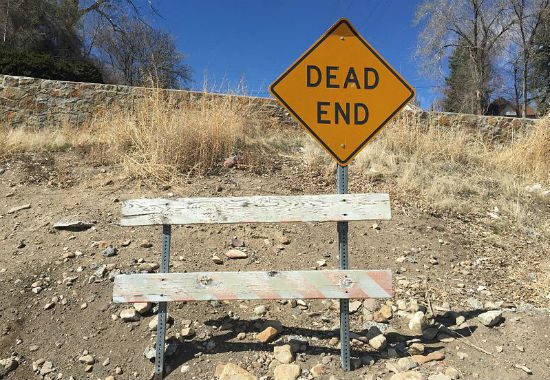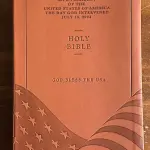Making a wrong turn onto a cul-de-sac is not something you want to do, but it’s much, much better than making a wrong turn anywhere else.
The thing about wrong turns is that you didn’t realize you were making them. That usually means that you’ll keep driving merrily along, blithely confident you’re still heading in the right direction while working your way farther and farther along in one of the many possible wrong directions. And the longer it takes you to realize that you’re not getting where you thought you were headed, the harder it will be to find your way back to the correct route.
That’s the nice thing about a wrong turn into a cul-de-sac. You’re quickly face-to-face with the end of the road. Once you reach that bag-end, it becomes undeniably clear that you’ve made a wrong turn. The dead-end street prevents you from going any farther astray.
A cul-de-sac is the best kind of dead-end street onto which to make a wrong turn because it’s got that little bulb at the end that lets you turn around easy peasy. Other types of dead-ends can be less convenient and less hospitable. Some can even be downright dangerous, forcing you to hit the brakes to avoid a Thelma & Louise-type scenario.
But the point here is that dead ends are clarifying. They stop people who are going the wrong way from continuing to go the wrong way. They force us to turn around, to acknowledge we’ve made a wrong turn somewhere, and to begin trying to find our way back to where we’re supposed to be. They may even humble us to the point where we’re willing to ask for directions.

So that’s my hopeful take on the exchange we looked at yesterday between religious historian Neil (N.R.) Young and evangelical seminary professor Richard Mouw. It’s pretty much the opposite of Mouw’s hopeful take.
Dr. Mouw is a mensch, and I admire his determination to see the glass as 10-percent full when seeking signs of a “[white] evangelical commitment to justice and peacemaking.” But Young is simply correct about the marginal nature and utter lack of consequence and influence of all the positive signs Mouw highlights.*
Here, for example, is Mouw:
Good things have also been happening during this past year. In January, 15,000 evangelical college students attending a major gathering sponsored by InterVarsity Christian Fellowship enthusiastically applauded a call by an African-American speaker to work diligently against racial injustice.
And here is Young’s response:
He notes that 15,000 college students at an evangelical conference in St. Louis last January “enthusiastically applauded a call by an African-American speaker to work diligently against racial injustice” and support the Black Lives Matter movement, but he conveniently ignores what soon followed. As Mark Oppenheimer pointed out in a piece for the New York Times, support for Black Lives Matter quickly dissipated among these young evangelicals once they realized the movement’s intersectional stance acknowledged that gay and trans lives mattered too.
But this brief spasm of concern for racial justice didn’t merely dissipate, it was crushed — forcefully and unambiguously. InterVarsity obsequiously apologized, groveling to be forgiven for the “sin” of briefly flirting with the idea of justice in an embarrassing display that rivaled the spectacle of World Vision’s hideous reversal on same-sex benefits. It was crushed and dismissed and marginalized and nerfed and “controversial”-ized the same way that every other such fleeting outbreak of “[white] evangelical commitment to justice” has been in my lifetime. And that includes both the original “Chicago Declaration of Evangelical Social Concern” that Mouw helped to write in 1973 and the 20th-anniversary sequel I helped to write in 1993.
Every such moment is a fork in the road — a potential opportunity to turn around, or at least to stop and ask for directions. And at every such crossroads, white evangelicalism repeats the same pattern. Every time.
Here, again, is a paragraph from Peter G. Heltzel’s Jesus & Justice: Evangelicals, Race & American Politics describing another such fork in the road for white evangelicalism. This one happened in 1965, but it outlines the pattern of what happens every time at every such crossroads, and why. As I wrote a couple years ago, “Understand and absorb these five sentences and you can understand the entire history of white evangelicalism in America over the past 50 years“:
In 1965 [Carl] Henry sent Frank E. Gaebelein to cover the march in Selma, Alabama. An associate editor of Christianity Today and the founder and headmaster of the Stony Brook School, New York, Gaebelein went to Selma and was so inspired that he wired Henry in Washington, DC, that evangelicals needed to join the march. But Gaebelein’s stories of the Selma march never saw the light of day. The resistance at Christianity Today was coming primarily from two people: J. Howard Pew, the Texas oil man and the financer of Christianity Today, and L. Nelson Bell, Billy Graham’s father-in-law and an editorial adviser at Christianity Today, who still had segregationist views. Pew and Bell did not want Christianity Today to speak out too critically against racism and capitalism, because they thought it would alienate important segments of the magazine’s constituency.
Heltzel understates Bell’s commitment to segregation. For Graham’s father-in-law, segregation was an essential, non-negotiable pillar of biblical Christianity. Opposition to it was, in his view, a threat to the gospel itself and a challenge to the authority of the Bible. And he didn’t just support segregation out of some vaguely conservative desire to preserve the way things have always been. He was a “curse of Ham” guy. Yeah, that garbage. And in 1965, not 1865.
And, again, he framed this white supremacy as a necessary component of “biblical” faith. If Ham be not cursed, then our proclamation has been in vain and your faith has been in vain and we are of all people most to be pitied. (Just as, today, Bell’s heirs insist that if gays be not condemned and excluded, then our proclamation has been in vain, etc.) Bell’s defense of white supremacy was thus always expressed in the most pious terms. It was, in his view, an a-political stance — simple biblical virtue untainted by the politicized concern for social issues of the muddling meddlers who threatened his pure white gospel.
Bell’s defense of white supremacy just so happened to align perfectly with the agenda and priorities of the wealthy donors financing white evangelical institutions. That always seems to be the case, whether those donors happen to be Texas oil men funding Christianity Today in the 1960s or soap-selling multilevel marketers funding white evangelical institutions today.
And so, for more than 50 years, white evangelicalism has been barreling down the wrong road, flying past every fork in the road that might have allowed it to turn around and head back to where it’s supposed to be. And, as the proverb says, if you don’t change where you’re headed, then eventually you’re going to get there.
Here we are. The wrong road that white evangelicalism has stubbornly been following has led us here, to 2016, and the election of Donald J. Trump thanks, largely, to the overwhelming support of white evangelicals. This is not an aberration, but a culmination. This is where that road takes you. It’s where you’re bound to end up if you drive long enough using only the segregationists and the wealthy donors as your GPS.
And that, folks, is the basis for the hope I have for the redemption of white evangelical Christianity in America: the clarity of a dead end.
Such clarity — what our friends in the church basement call “rock bottom” — is a somewhat grim and bitter basis for hope, but it seems more solid than imagining that the next generation of “declarations” or “manifestos” will be some kind of tipping point.
Alas, the moment of clarity provided by this dead end has not yet fully arrived. You may see what lies immediately ahead, but the majority of white evangelicals who voted for Trump haven’t yet been forced to confront the reality of what is about to happen. They’re still, bless their hearts, celebrating what they see as a great victory over Hillary and other imaginary forces of darkness. But the deadness of this dead-end will — gradually but inexorably — become clearer to them over time.
As that happens, they will ask themselves How did we get here? And they may say to themselves, My God, what have we done?
And then — at long last, but only then — we may finally get beyond same as it ever was. And then redemption may be possible.
I appreciate, too, that no matter how deadly this dead end becomes, there will also be many dead-enders who refuse to accept that they ever took a wrong turn or that this is the wrong road. They’ll treat this dead end as a destination, treat rock bottom like Plymouth Rock, and build a settlement here — creating a new Drumpfskirche in honor of their new normal and their new lord and savior. But I don’t think that will be all or most white evangelicals. And their blasphemous example will prod others to turn around and head back to the way they left so long ago with a newfound humility that may even allow them to ask for directions from someone other than the voices that led them astray.
Maybe. That is, anyway, what I hope will happen. And that’s all the hope I can muster at this point.
– – – – – – – – – – – –
* Among those signs Mouw notes the newfound zeal in recent years of white evangelicals who “want to put an end to … sex trafficking.” This is neither new nor actually hopeful.
Don’t get me wrong. Human trafficking is a Bad Thing. And it would be a Good Thing if white evangelicals worked against it in some kind of sidekick capacity. But this new crusade is a bit too much like its earlier incarnation — the “white slavery” panic of the early 20th century. As such, it’s tailor-made to reinforce some of the biggest and most cancerous sins woven into white evangelical Christianity in America: white supremacy, purity culture, and the intoxicating self-righteousness that imagines we are pure champions fighting against Satanic baby-killers and therefore sole possessors of the moral high-ground whose basic goodness and rightness must never be questioned.
It’s the kind of thing that starts out sounding like an “evangelical commitment to justice” and winds up just being a way for white folks to congratulate themselves on their moral superiority after throwing Jack Johnson in prison for riding in a car with his white girlfriend.












